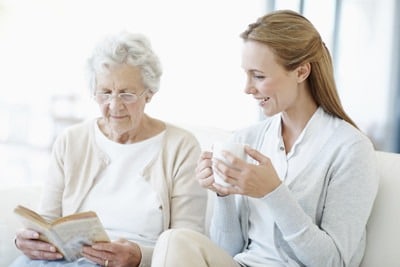Connect, Create, and Contribute
Every May, the Administration for Community Living leads the national observance of Older Americans Month. The month-long celebration focuses on healthy aging strategies, addressing challenges to community living for older adults, strides in elder care research to improve medical support systems, and changing senior landscapes.
May is also a celebration of significant turns in legislation and science that have had an immediate impact on the quality of life for older Americans.
The Expansion of the SNAP program and the Older Americans Act to help alleviate the financial burden of aging and the risk of malnutrition.
National Anti-Aging Movement
Preventable Issues Drive
Healthy Aging Strategies
One of the most significant focuses of Older American’s Month 2019 was aging as healthily as possible. The science behind aging is reasonably conclusive when it comes to the causes of overall health degradation. Put as simply as possible, aging itself is a slow decline in health. Not taking the proper steps towards aging healthily substantially accelerates the whole process drastically by introducing everything from heart disease to diabetes. While many of the health challenges we face as we age are unavoidable and a natural part of the aging process, there are countless avoidable health debits that can be better managed by seniors. There is a laundry list of healthy living strategies, and trying to parse all of them out can be incredibly intimidating; for the sake of simplicity, a few are listed below.
Keep consistent track of blood pressure to maintain heart health
Start thinking about diet before any health issues arise
Practice preventative care
Exercise, exercise, exercise! You will thank yourself for it in the years to come
Maintain an uncluttered living space
Addressing Challenges to Community Living
The research on the positive health benefits of community is robust and conclusive. It is a fact that seniors, and any other humans really, benefit significantly from both a mental and physical health standpoint by participating in some form of community.
Contrary to popular belief, this doesn’t mean living in a senior home or giving up even a shred of independence. There are millions of healthy people participating in community events every day. Bake sales, volunteer work, staying active in your grandkids lives, even just getting out and doing the shopping. There are so many ways to get out and about with other people, and the benefits are numerous and undeniable.
The Connect aspect of Older American’s Month speaks on this point at length, with a particular focus on new prescriptions that began being offered this year. Doctors can now medically prescribe “Socialization” to seniors that are suffering from issues related to isolation or depression. The early results show substantial improvements in mental health, which tend to have positive effects on physical health nearly across the board.
Expansion of the SNAP program
Between 40-50% of all retired seniors are estimated to suffer from some form of malnourishment. While malnourishment can be caused by a lack of nutrients, it is most often caused by a lack of consumption. Millions of seniors can barely afford food, and the food that they can afford is often severely lacking in vitamins and nutrients. Picture a college students’ diet, with a senior’s immune system, and you can imagine why malnourishment is such a massive health issue for seniors.
The SNAP program was expanded in 2019 to include a more significant percentage of a growing senior population, providing millions with proper dietary options. However, it has been an uphill battle informing as many seniors as possible of the benefits available to them. There was very little press surrounding the expansion of the program, and adoption has been limited, even though it is a godsend. Another challenge that has proven difficult to navigate is pride. Most individuals on social security at this point are Baby Boomers, and selling any form of government assistance to them is extremely touchy. Regardless, OAM 2019 focused heavily on spreading this information, and hopefully by this time next year, the discussion will be centered around how effective these adoption campaigns have been.
National Anti-Aging Movement
There is a national movement to remove language related to anti-aging from products and general medical terminology that has taken flight this year. AARP officially announced that they would no longer advertise anti-aging products or run any articles related to the subject. Citing the term as something that stigmatizes the completely natural and healthy aging process. There is no need to be “anti-aging” since aging itself isn’t a bad thing at all.
The language has shifted towards aging with happiness, or grace. Instead of continually saturating seniors with all of the ways they can prevent something inevitable, the focus is on owning seniority. It is an excellent message, and based on the trends being established this year, it will likely only continue to grow as more large senior brands adopt it.
Preventable Issues Drive
Seniors practicing preventative care is a subject every single May, and every other month of the year. There are so many health issues that can be avoided completely by regular visits to your doctor and a healthy diet. AARP and thousands of doctors went on record this year stating that the single most important aspect of aging well is preventative care.
The most relevant issue seniors can avoid almost entirely, barring genetic predisposition, is heart disease. Heart disease is by a large margin the leading cause of death in Americans, specifically those that are seniors or middle-aged. There are medications that can help minimize risk once it is diagnosed, but it is better to just avoid the diagnosis entirely. Other issues include diabetes, glaucoma, Alzheimer’s & Dementia, and arthritis. All avoidable or at the very least minimizable with preventative care.
The drive for exposure this year has included the previously mentioned doctors’ campaign. Nearly every long-term care location or senior healthcare provider has also bought in. In some cases, with flyers in their waiting rooms, in others with full-on exposure campaigns that work with seniors interactively to get them moving.
Changing Senior Landscapes
Every year for Older Americans Month, the state of senior housing and accommodations is a primary focus. This year specific mention of the health benefits of maintaining independence well into your golden years was made.
There are several suggested ways to make sure you can age at home, or at the very least on your terms. Most of them root in maintaining or improving health, since at the end of the day being able to administer self-care is the primary barometer for independence. This has been the case every year since OAM started, physical health leads to independence, which maintains mental health, which facilitates healthy and vibrant aging.
There has been a slow, but steady shift in the landscape of senior housing that is beginning to reach a fever pitch, however. 2019 was a year of focus on how to maintain independence even with health issues that would typically force seniors into long-term care communities or nursing homes. Historically senior care took the “shotgun” approach towards long-term living. If a single health issue prevented independence, even if it required 30 minutes a day to address, a senior home was typically the answer. This led to a complete lack of independence and often culminated in the spiral so often associated with poor nursing home care.
A more precise method of care is growing increasingly popular now, at-home care. Not every senior requires round-the-clock medical attention and on-call medical staff; most don’t as a matter of fact. If you can handle most of your activities of daily living but have trouble bathing, for example, there is no reason you should have to move into a nursing home. You can age in place, and all it requires is a 30-minute daily visit from an at-home care professional. To put it into a term, the landscape for senior care in 2019 is shifting towards personally tailored care.
If you or a loved one are interested in a consultation to see which in-home care services would be right for your loved one, we can help. We refer qualified and compassionate care providers who can help with many different services to help prepare your loved one for the future and keep them home. For more information about our services and coverage area, contact us to speak with a Client Care Liaison.
Interested in our Senior Care Services ? Click here to see our locations and service areas.
Interested in Care Provider opportunities? Click here to start registration.


 Parkinson's Disease (PD) cannot be cured. But it can be managed, and quite effectively at that. Aside from medications and possible surgery, lifestyle changes such as
Parkinson's Disease (PD) cannot be cured. But it can be managed, and quite effectively at that. Aside from medications and possible surgery, lifestyle changes such as  Falls among the elderly are a leading cause of debilitating injury
Falls among the elderly are a leading cause of debilitating injury